I'm overdue for a story from Cornie Hubner. My excuse is that Emma and I were waiting for a beautiful sunny day to take photos of the OLM Chapel. Here is Cornie's Didja Know? article about Our Lady of the Magnificat, in Kinnelon, which he wrote when OLM was celebrating its 25th Anniversary. Fitting to share it with you as OLM celbrates its 50th Anniversary [see OLM: Looking for Founding Parishioners].
Our Lady Of the Magnificat
by Cornie HubnerSt.Hubert's Chapel, in the lake, was the first consecrated Roman Catholic place of worship in Kinnelon in 1886. It was the private chapel of the Kinney family, served by the Franciscan priests of St. Anthony's Mission of which the few local families were communicants. It was not until 76 years later, in 1962, that the first official mass was celebrated in the newly formed mission of Our Lady of the Magnificat. It was named after the gospel of St.Luke, "My soul doth magnify the Lord," by Henry Wise Miller who donated the Chapel buildings and land to the Diocese of Paterson in '54.
The acreage, part of parcel owned by Robert Morris in the early 1700s, was purchased by Miller in 1925. Nationally recognized in his own right, Henry numbered among his ancestors a descendant of an officer in Wellington's command at Waterloo, George McCullough, the designer and builder of the Morrris Canal, an early president of Harvard and the last Whig U.S senator. He designed and built three stone houses, in one of which he reassembled the Captain's cabin of an old four master. Its exquisite walls were a fitting background for his priceless collections.
Shown only to close friends, his jades, loosely fondled by the lucky ones, left them breathless when they later learned the value of what they had been privileged to handle. The collection of silverware, represented the artistry of every continent. As a dealer, he maintained contact with others by mail and the exchange of 8x10 photos, sometimes taking up to a year to exchange or purchase a unique or historic masterpiece. His book on the subject was a bible for the trade.
Following a politically doomed business expierience in Brazil, he pirated thousands of rubber tree seedlings for planting in Cuba. There, shortly after the Spanish-American war, he started a plantation at the eastern extremity of the island. After several years it was apparent that nature would not cooperate and he transferred his unbounded energy to a succesful Wall Street career. This led to his marriage to a famous socialite author.
Alice Duer, his first wife, a descendent of the defender of New York City, one of Washington's trusted officers, and two early Colombia University presidents, was born on a large estate on the bluffs overlooking New York City. After several successful novels, she turned her talents over to poetry. Her "White Cliffs of Dover" became an international sensation. It had 33 editions and sales of 700,000 that made it unique in '45. Read by Lynne Fontaine to the accompaniment of an original scored symphony it started a trend popularizing many records for home enjoyment.
Henry loved his wife dearly and attempted to share his feelings in his book "All Our Lives," published in '45 after her death. Two English Copper Beech trees, which he accompanied from England, were planted for her, in the 20s at the then rumored astronomical cost $750.00 each. They prospered and added the open English countryside touch to the area where the Chapel was built.
Modeled after an ancient church that he had seen in Harescombe, England, Henry corresponded with church authorities until he completed the plans from which the edifice was built. In failing health, he was carried on the crossed hands of his workers, to surpervise its daily progress until completion. Affirmed
in the Catholic Faith, he died shortly after and his funeral Mass was the first in his beautiful Chapel.
From 1954, the Diocesen Estate, with its Chapel and buildings was in the custodial supervision of the Order of Salvadorian Fathers. The Polish Prelates transferred to their Gary, Indiana headquarters in 1961 when Fr. John R. Ryan was assigned to the newly designated Mission. On his arrival, he wondered what he did wrong to warrant his banishment. Now, as Monsignor, he wonders just what to do to remain. With the help of a sympathetic family and encouraging welcoming parishioners, much was quickly accomplished.
The first Official Parish Mass was held in '62. The Chapel was soon bursting with worshippers frequently obliged to participate in open doors and windows (a bit discouraging in rain and freezing weather). The need for expansion forced the construction of a school with a large auditorium that could accomodate the ever
increased attendance at several Masses. The first class entered school in '64 when the first Mass was celebrated.
The Cemetry was opened in '65 and a drive for Church started in '70 culminated in '73 with the dedication of the beautiful monument to the faith and loyalty of congregation. Father Ryan, now Monsignor, with his associates Pastors William J. Mooney and Richard J. Messenlehner, provide for five Sunday and one Saturday evening Masses for the 850 families in the parish. The Sisters of St. Joseph of Chestnut Hill originally staffing the first four classes, now supervise eight classrooms, a Kindergarten and Pre-Kindergarten.
The 25th Anniversary will be fittingly celebrated later this year when a more detailed history will be published. "Our Lady of the Magnificat" will always be an influence for good, that parishoners and the entire community are thankful for and wish continued success.
~Cornie
----
Thank you, Cornie!
Here are a few more photos that Emma and I took when we visited Our Lady of the Magnificat's Chapel.
We love closeups of stone. Marvelous texture and color, don't you think?
Special thanks to Emma for typing up Cornie's article.


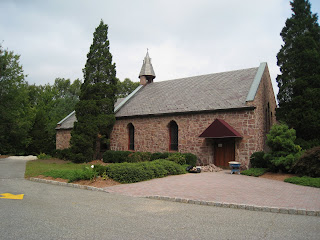

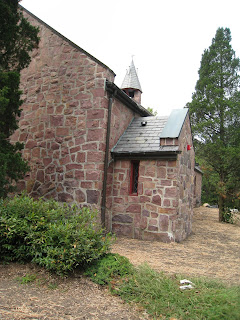
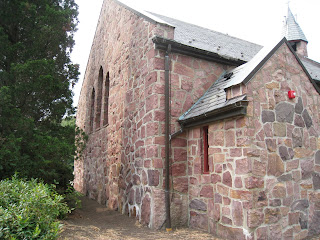

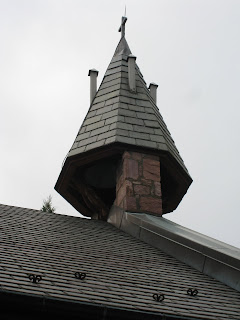

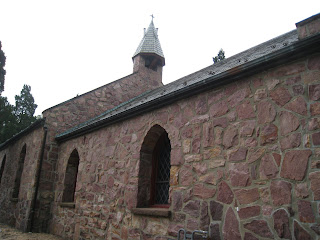
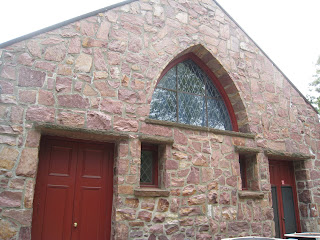
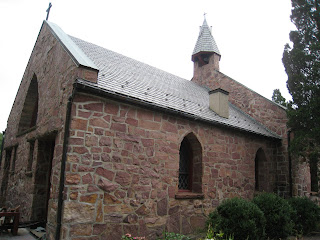

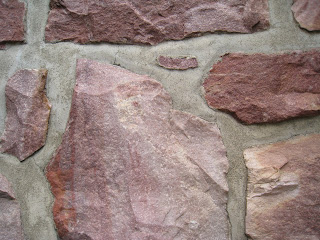
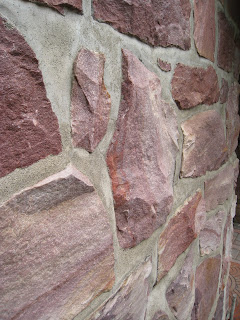
Hello - I have enjoyed your posts on the history of the Our Lady of the Magnificat chapel and of Kinnelon - it looks like heaven on earth. I hope to visit the area this spring. I am conducting some research on Henry Miller and was wondering if you or anyone might know any other resources in the area. I am writing a book on a close friend of Mr. Miller's, Daisy Bacon. Thank you for any information! Laurie Powers; lauriepowers12@gmail.com.
ReplyDelete